PlumeStop Application Pilot Study: Former Dry Cleaner Site, USA
Approach
A beta-test pilot evaluation of PlumeStop™ performance was conduced on chlorinated solvent groundwater contamination at a former dry cleaner site. PlumeStop was applied in conjunction with the slow-release electron donor, HRC® and the microbial bioaugmentation dechlorinator inoculum, BDI® for the treatment of residual PCE (550 μg/L). The test was conducted around a single well. Conditions prior to the test were aerobic (ORP +254 mV; DO 44%). Multiple parameters were monitored from groundwater samples to explore lines or evidence of solvent fate / degradation.
2m 27s reading time
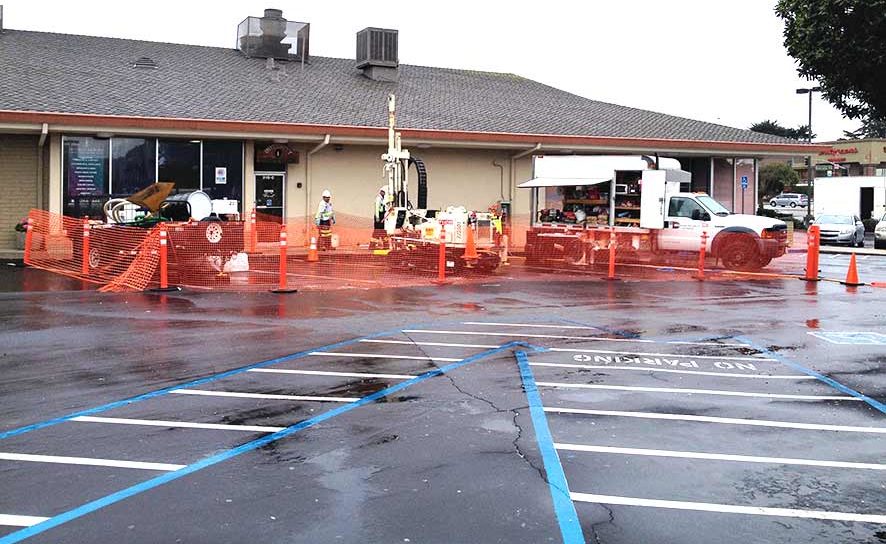
Results
Post-treatment solvent concentrations in groundwater were reduced by over 99% to non-detect (<5μg/L) by the first sampling round (19 days). Microbial quantitative array data revealed marked increases in reductive dechlorinator species from baseline conditions in the months following reagent application (several hundred percent or more). (Baseline taken as immediately post-inoculation for species included in BDI). Moreover, functional enzymes for dechlorination of PCE through to ethene similarly increased over the same period (i.e. including specific genes for the degradation of TCE, DCE and vinyl chloride). Through this time, groundwater concentrations of PCE and daughter products remained below detection limits (>15 months post treatment).
Electron donor status and redox potential post-application quickly stabilised at near-optimal conditions ( 150mV +/- 30 mV), with rapid decreases in competing electron acceptors observed within the first sampling intervals, albeit with some interplay with available iron, possibly reflecting an electron shuttle dynamic with iron naturally present within the formation. The redox remained below methanogen activity thresholds – methanogen numbers did not share the trends observed in dehalorespirers, and in fact were detected above quantitation thresholds (2 – 30 cells /ml) in one sampling event only, at significantly lower cell counts than Dehalococcoides (94 vs. 12,200 cells/ml).
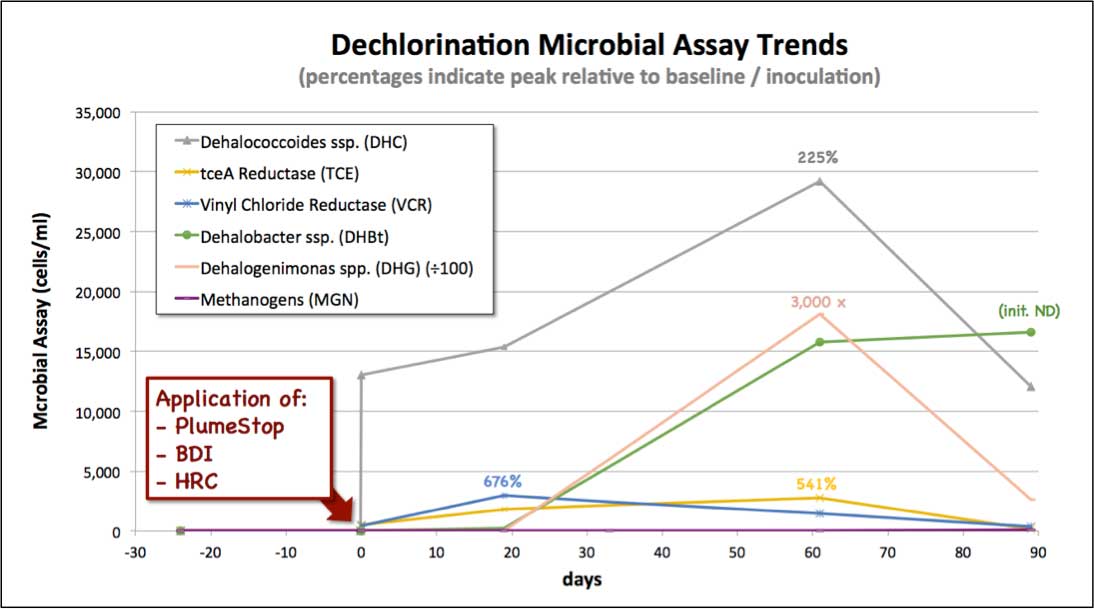
Discussion
The continued expansion and proliferation of an active dechlorinating microflora in the months following inoculation are indicative of solvent biodegradation through this time. That no solvent was present above detection limits in groundwater through the same period would indicate the degradation to be proceeding ostensibly from the sorbed phase (i.e. PlumeStop/water interface). This would be consistent with the PlumeStop bio-matrix hypothesis. It is also of note that the dechlorinator numbers and activity peaked at approximately sixty days and declined thereafter. Although the data set is limited, this trend would be consistent with the presumed depletion of the solvent through degradation, the starting concentration having been only 550 μg/L.
Conclusion
These data provide lines of evidence for post-sorption degradation of the target solvents on the PlumeStop, and would further indicate that methanogenic conditions are not necessary for complete reductive dechlorination activity through to ethene. Moreover, all data were obtainable from groundwater samples presenting a straightforward means of performance tracking via wells using the lines of evidence approach.
What’s Special
- Depletion of groundwater solvent concentrations to non-detect within 19 days
- All Contaminants of Concern (PCE and daughter products) are remaining below detection limits 15 months post application (and counting)
- Multiple lines of evidence for post-sorption solvent degradation
- All data obtainable from groundwater samples alone
- No generation of methane / competition from methanogens
PlumeStop® Applied to Former Electronics Facility in Indiana Achieves 99.9% Reduction in 2 Months
Project Highlights
- 92% reduction within two weeks
- 99.9% reduction in two months
- Combined remedy approach reduced mixed VOC plume to non-detect within nine months (<5μg/L)
- No rebound in over 18 months of site monitoring
1m 31s reading time
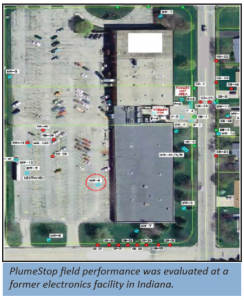
Project Summary
An evaluation of PlumeStop performance was conducted on a section of a mixed chlorinated solvent plume (cVOC) comprising trichloroethene (TCE – 1,390 μg/L) and 1,1,1-trichlorotethane (TCA, 3,550 μg/L) at a former electronics facility in Indiana. PlumeStop was applied in conjunction with the controlled-release electron donor, Hydrogen Release Compound (HRC®). Post-treatment solvent concentrations in groundwater were reduced in two weeks by 92% at the first sampling round. Concentrations were reduced by 99% by the second sampling round (one month) and 99.9% by the third sampling round (two months). No cVOCs were detected above analytical thresholds (<5μg/L) after three months. Source area treatment activities are being monitored for closure and the results are being evaluated as a potential larger scale plume treatment option.
Remediation Approach
PlumeStop was applied perpendicularly to the groundwater flow using 10 direct-push injections around a central monitoring point. Approximately 180 pounds of HRC was applied into three injection points.
REGENESIS Solution Applied
PlumeStop is an innovative in situ remediation technology designed to rapidly reduce contaminant concentrations, stop migrating plumes, eliminate contaminant rebound, achieve stringent clean-up standards and treat back-diffusing contaminants. PlumeStop provides a unique colloidal biomatrix platform which rapidly sorbs contaminants out of the dissolved-phase. Once contaminants are concentrated within the PlumeStop biomatrix, they can be completely biodegraded in place using compatible REGENESIS bioremediation products.
HRC is a controlled release, electron donor material, that when hydrated, is specifically designed to produce a controlled release of soluble lactate. The newly available lactic acid is highly efficient for the production of dissolved hydrogen to fuel anaerobic biodegradation processes in soil and groundwater.
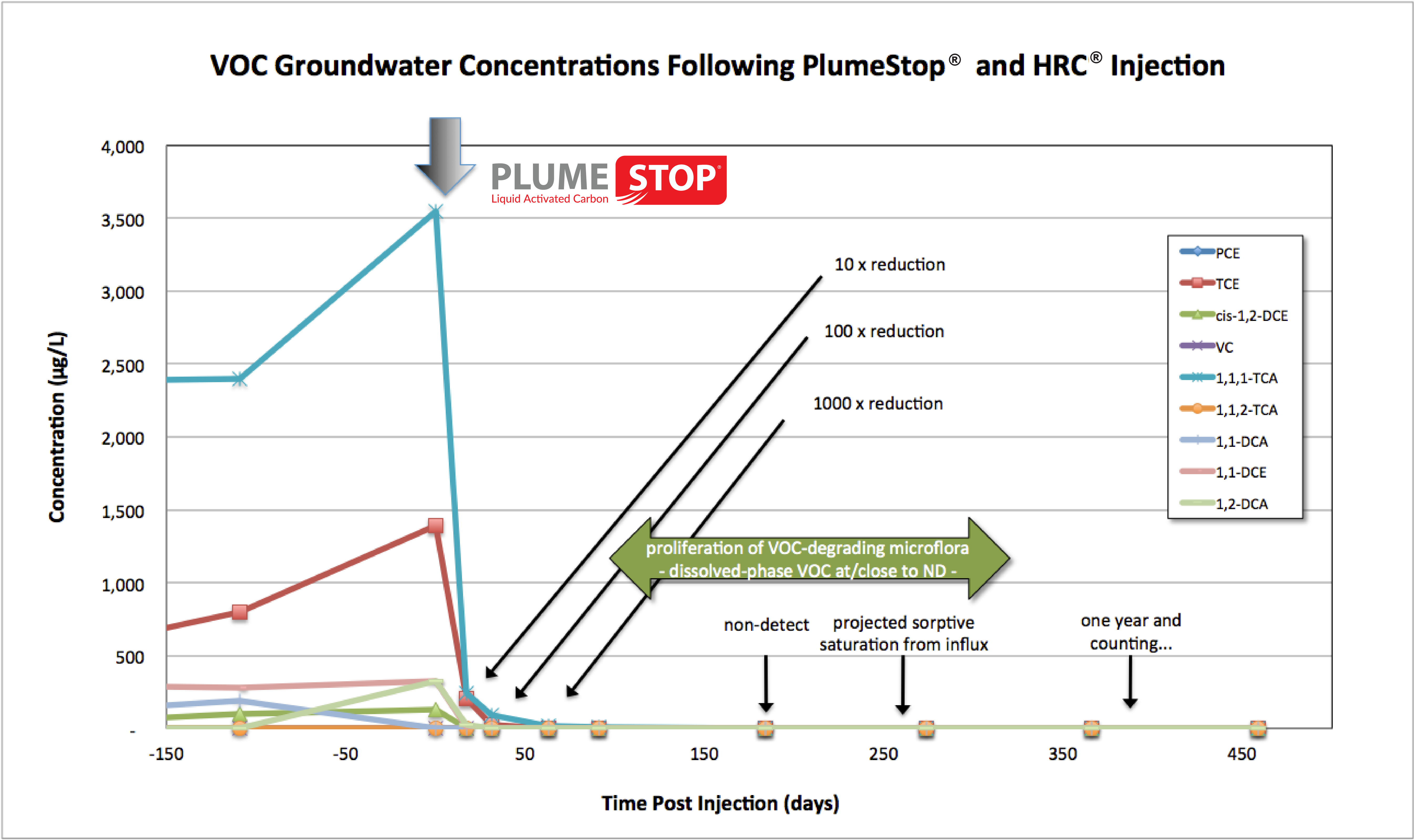
Results
Using a combined remedy approach, the application of PlumeStop and HRC successfully reduced contaminant levels to non-detect and positioned PlumeStop as a viable solution for larger scale projects.
Long-Term Chlorinated Solvent Treatment using a Controlled-Release Microemulsion
PROJECT SUMMARY
- Dry cleaning operations resulted in a chlorinated solvent plume with concentrations as high as 700 micrograms per liter (μg/L) in chlorinated solvents
- Typical Midwestern geology: Silty clay with intermittent sand stringers underlain by a clay till confining layer
- Contaminants of concern within the silty clay aquifer included tetrachloroethene (PCE) and trichloroethene (TCE) (see Table 1)
- High sulfate environment (~100 mg/L) – potential inhibitor for successful remediation
- Cleanup goals were based on the Industrial Risk Integrated System of Closure (RISC) levels
- Enhanced anaerobic bioremediation of chlorinated solvents in groundwater using 3-D Microemulsion (3DMe)®
- $195,000 (Costs include 3DMe® material, injection, field oversight, 2 yrs post injection monitoring, project management and report writing)
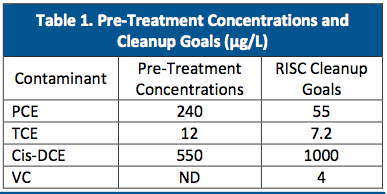
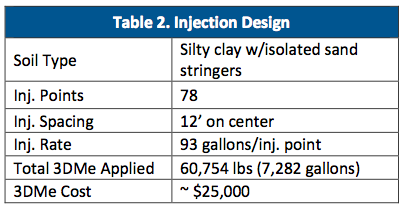
RESULTS
- The 3DMe application overcame high sulfate levels and resulted in a reducing environment lasting almost 2 years
- Sampling at 22 months post-3DMe indicated sustained low levels of ORP (-136mV) and DO (1.3mg/L)
- Reduction of chlorinated solvents by 83% to 98% in all impacted wells
- Site is pending closure from regulatory agency
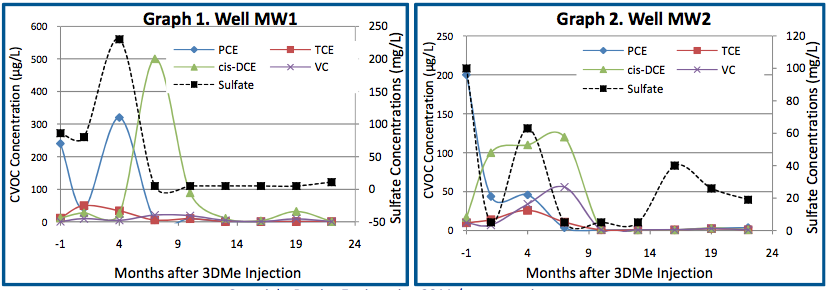
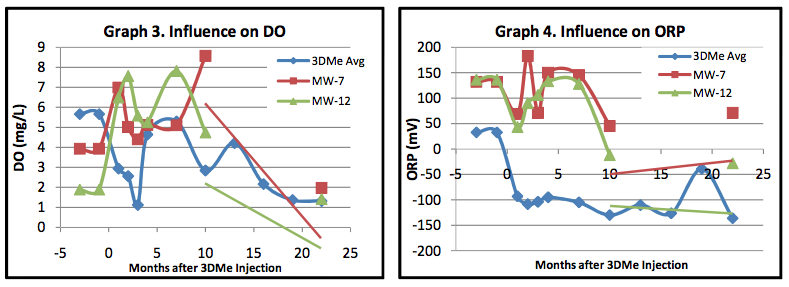
ELECTRON DONOR INFLUENCE
Analytical parameters including oxidation-reduction potential (ORP), dissolved oxygen (DO) and total organic acids (TOAs) were monitored to verify the influence of the electron donor post-injection. The monitoring wells likely influenced by 3DMe (MW1-3, MW5, MW14-17) were analyzed on average and compared to background wells MW7 and MW12.
Within the 3DMe influence area:
- On average, ORP reduced to -100mV and DO levels declined to ~2mg/L (Graphs 3 and 4)
- Concentrations of TOAs were detected at >1,000 mg/L during the first 10 months of
monitoring
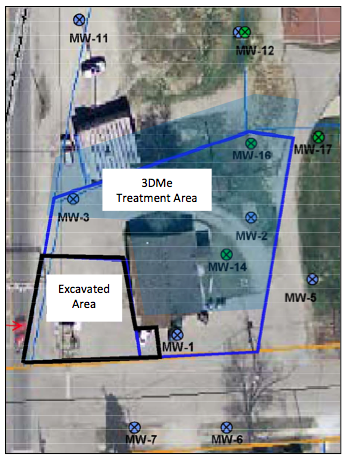
RegenOx® Treats Benzene in Low Permeability Soils
Introduction
Service station operations created a benzene contaminant plume in tight subsurface soils. A dual-phase extraction system (DPE) was installed and removed a total of 9,965 pounds of petroleum hydrocarbons over two 90-day operational periods. However, contaminant removal reached asymptotic levels and a more effective remedial strategy was needed to address the remaining benzene concentrations. The DPE system was shut down in December 2004 and RegenOx® was selected to evaluate the effectiveness of reducing benzene and MTBE concentrations in tight soil lithology.
Description of Activities
RegenOx was pilot tested around well DPRW-6 to evaluate its effectiveness in tight soil. A total of 1,439 pounds of RegenOx was applied near well DPRW-6 as a pilot test in August 2005 (510 lbs) and July 2006 (929 lbs). Benzene concentrations declined within 15 weeks by 76% and successfully reached the Site Specific Target Level (SSTL) (Graph 1), prompting a design for full scale implementation.
The objective of full-scale treatment was to provide rapid mass reduction of benzene concentrations and reach the SSTL of 20.1ppm across the 9,100 ft2 source area. Benzene rebound at DPRW-6 (the original pilot test well) six months post-injection suggested that a previously unidentified plume had re- contaminated that area. After additional site characterization was completed, 7,110 pounds of RegenOx were applied during six injection events over five treatment areas (Figure 1).
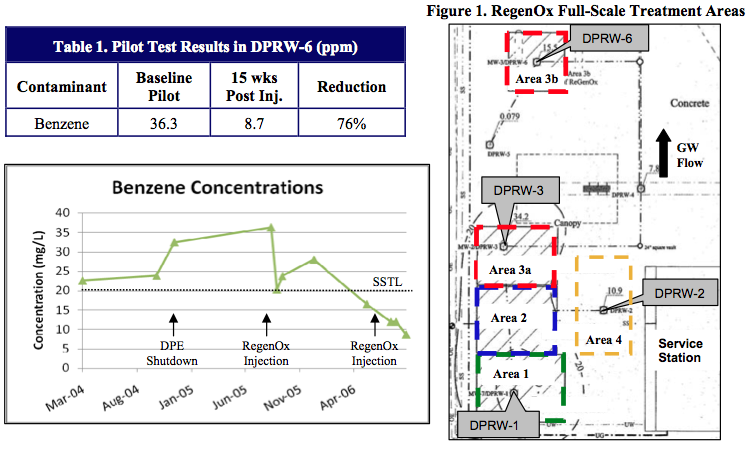

The RegenOx injections were performed over a 6 month period due to weather delays. Monitoring was conducted to observe potential contaminant rebound from areas requiring additional injections. The applications targeted a treatment thickness of 14-20 feet bgs into silty clay with intermittent sand “stringers”. RegenOx was injected using a top-down direct-push injection technique with 5-15 lbs of RegenOx injected per vertical foot.
Results
Prior to the full-scale application, benzene concentrations exceeded the SSTL of 20.1ppm in all wells. Monitoring over a 7 month period prior to remedial treatment indicated an increase in concentrations from 12 – 32ppm to 20.4 – 44.1ppm.
RegenOx was applied over six injection events as indicated in Table 2. Sampling conducted
after the final application event in December 2007 indicated a benzene reduction to at or below the SSTL in all wells (Graphs 2) including the original pilot test well DPRW-6. As monitoring continued, a decline in benzene concentrations persisted via natural attenuation and all wells sampled below 10ppm in August 2009. Based on the reducing trend observed over the past 12 months, the site was recommended for closure.
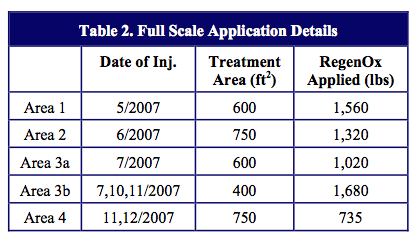
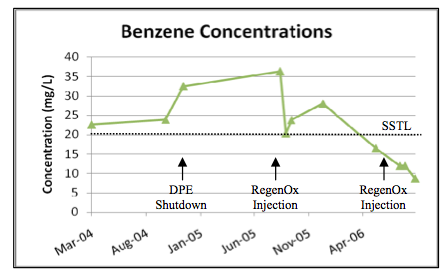
Rapid Reduction of VOCs Results in Site Closure
Summary
Subsurface investigations at a dry cleaning facility revealed elevated levels of PCE and other regulated daughter products. A remediation technology was needed that could cost-effectively reduce the contaminants to the Washington Department of Ecology’s (WDOE) cleanup levels. HRC was chosen for groundwater remediation due to its ability to provide a low cost solution for site restoration. A groundwater monitoring program was created to assess the efficacy of remediation. The results from this program indicate a significant reduction in all contaminants and provides convincing evidence that the application of HRC to a chlorinated solvent contaminated site results in successful site cleanup.
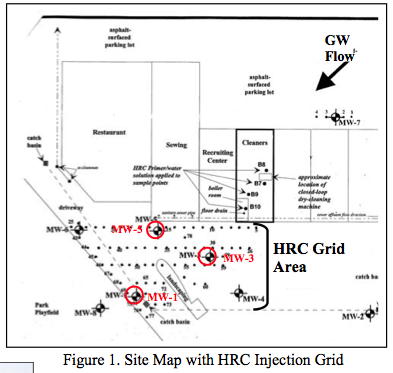
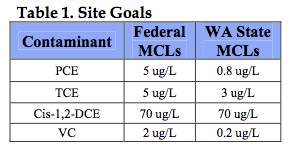
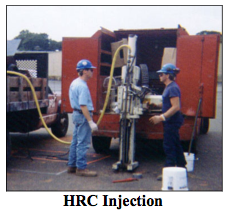
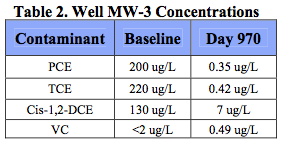

Conclusions
Total VOCs were reduced across the HRC grid area shortly after injection. Wells MW-1, MW-3, and MW-5 (Graph 2) were situated within the HRC grid area and thus represented the behavior of HRC. The results indicate a significant reduction in the concentration of PCE and its related daughter products. PCE and TCE were reduced by 99.8% and DCE was reduced by 94.5%. Similar results were displayed in all other wells affected by HRC. As a result of HRC treatment, PCE, TCE, and DCE levels have been reduced to 10 times below the federal standards. Although VC has dropped to 4 times below federal standards, contamination levels still exceed WDOE MCLs of 0.2 ug/L. This site is expected to gain regulatory closure in the near future once VC is reduced to 0.2 ug/L.
3-D Microemulsion® Enhances Reductive Dechlorination and Reduces PCE and TCE Concentrations to Non-Detect
CASE SUMMARY
Operations at a dry cleaning facility in Illinois resulted in elevated levels of chlorinated ethenes in the subsurface. Downgradient of the contaminant source (in Well MW-4), the total chlorinated compound concentration was greater than 6,400 parts per billion (ppb), the main contaminant being tetrachloroethene (PCE). A pilot test using Hydrogen Release Compound (HRC®) was initially designed and deployed to produce conditions favorable for the reduction of contaminants. Well MW-4 was the designated sampling point to observe the contaminant reduction. The HRC pilot application was mis-applied over a 20 foot vertical interval instead of the recommended and planned 10 foot interval, resulting in under-dosing of HRC and only moderate treatment performance. A second application was performed 18 months later using the correct dosing of 3-D Microemulsion (3DMe)®.
REMEDIATION APPROACH
3-DMicroemulsion is a completely new molecule with staged hydrogen release capabilities and is applied as a microemulsion for enhanced distribution. The 3-D Microemulsion was directly injected at 6 locations surrounding the targeted monitoring well MW-4 (Figure 1). It was injected at a rate of 120 pounds per injection point and at 10 to 20 feet below ground surface (at the correct 10 foot interval). The injection points were spaced approximately 7 feet from one another.

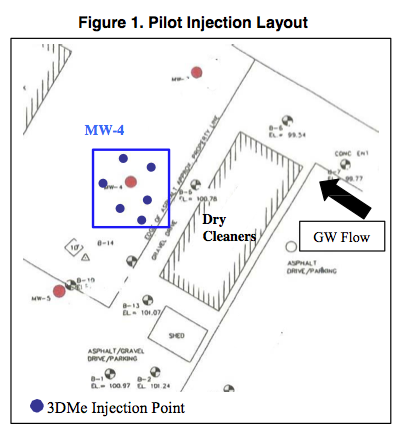
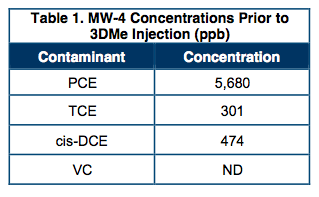
RESULTS
Although HRC was applied and under-dosed in September 2004, moderate increases in the reductive dechlorination process were observed near Well MW-4. The moderate effect resulted in a 50 percent decrease in PCE concentrations. As expected some daughter products were also produced.
Within 30 days of the 3DMe application, PCE was reduced from 5,680 ppb to non-detect followed by a similar reduction in TCE. A reduction of 77 percent was observed in cis-DCE between August 2006 and April 2007. Slight increases in vinyl chloride (VC) and ethene indicated that complete dechlorination was occurring with no stalling effect (Table 2).


CONCLUSION
Biostimulation using 3-D Microemulsion was successful in treating the target contaminants as a result of the proper dosing/emplacement of the material and overall product performance. In MW-4, PCE and TCE were reduced to non-detect while total chlorinated compounds were reduced by more than 70 percent.
3-D Microemulsion® Bio-Barrier Rapidly Treats Cis-DCE and Vinyl Chloride Contamination and Maintains Reductive Dechlorination Over a 1,200-Day Period
CASE SUMMARY
Cis-1,2-dichloroethene (cis-DCE) and vinyl chloride (VC) were migrating off-site at this commercial facility. A pilot test of enhanced anaerobic bioremediation was performed to determine if a bio-barrier using 3-D Microemulsion, a form of HRC Advanced®, could effectively reduce the cis-DCE and VC contamination before it moved off-site. The remediation design included the subsurface injection of 3-D Microemulsion upgradient of contaminated well MW-9.
TECHNOLOGY DESCRIPTION
Reductive dechlorination is a process used to degrade certain contaminants in groundwater (e.g., cis-DCE and VC) to ethene. 3-D Microemulsion is a highly effective agent to facilitate this process. 3-D Microemulsion is composed of free lactic acid, controlled-release lactic acid (polylactate), and certain fatty acid components esterified to a carbon backbone molecule of glycerin. When injected into contaminated soil and groundwater, 3DMe produces a sequential, staged release of its electron donor components. The immediately available free lactic acid is fermented rapidly while the controlled-release lactic acid is metabolized at a more gradual rate. The fatty acids are converted to hydrogen over a mid- to long-range timeline giving 3DMe an exceptionally long electron donor release profile. This staged fermentation provides an immediate, mid-term, and very long-term controlled release supply of hydrogen (electron donor) to fuel the reductive dechlorination process.
REMEDIATION APPROACH
The objective at the site was to demonstrate the ability of 3-D Microemulsion to prevent the off-site migration of cis-DCE and VC by contaminant reduction. The reduction was to be achieved by the introduction of 3DMe into the subsurface through 8 injection points spaced 5 feet apart (Figure 1).

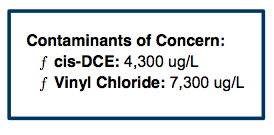
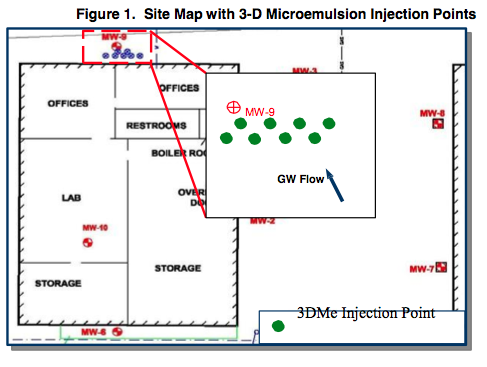
RESULTS
Within 60 days of the application of 3-D Microemulsion, concentrations of the target contaminants were significantly reduced (Table 1 and Figure 2). Over the 1,200-day monitoring period, cis-DCE was reduced by a magnitude of 3 from 4,300 to 3 micrograms per liter (μg/L). VC was reduced by 2 orders of magnitude from 7,300 to 24 μg/L, interrupted briefly by an anomalous spike likely to be laboratory error. As a result of this process, ethene concentrations increased by 102 percent, from 3,100 to 6,500 μg/L, after 130 days (a clear indication of complete dechlorination). Elevated levels of ethene were maintained for more than 300 days until ethene monitoring ended at Day 350 (Figure 2)

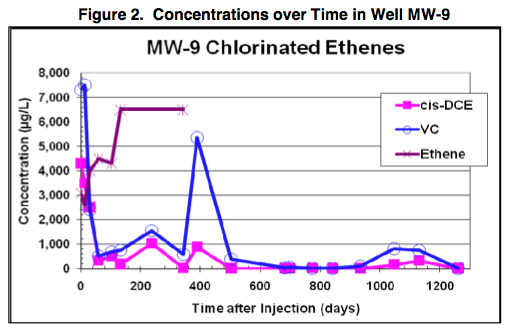
CONCLUSION
Overall, the results of this pilot test clearly show that when using 3-D Microemulsion, chlorinated ethene degradation via enhanced reductive dechlorination can be achieved both rapidly (60 days after injection) and successfully maintained over the long term.
DOD Treatability Study Documents Successful Carbon Tetrachloride Remediation using HRC®
Contaminant Concentrations Reduced by 99% Within One Year
Project Highlights
- Treatability study demonstrated effective reduction of carbon tetrachloride and benzene contamination
- Combined application of HRC® and HRC Primer® reduced carbon tetrachloride concentrations to below cleanup goal within one year
- Influx of additional carbon tetrachloride contamination to the site was buffered by enhanced anaerobic bioremediation
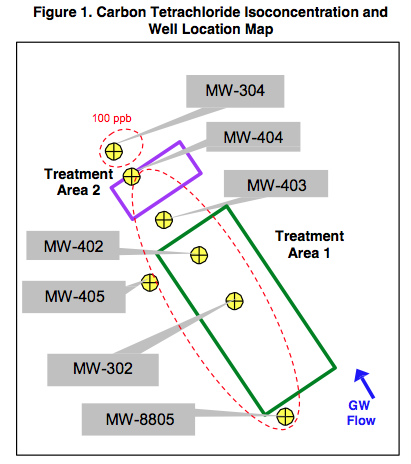
Project Summary
Historic operations at a Department of Defense site in Maryland resulted in soil and groundwater contamination with carbon tetrachloride, benzene, and chloroform at concentrations of 274 μg/L, 178 μg/L, and 21 μg/L, respectively. Monitoring at the site revealed decreasing trends in contaminant concentrations as a result of natural attenuation. However, the site was on a redevelopment schedule and monitored natural attenuation was deemed to be too slow and costly.
The Air Force, in conjunction with the Comprehensive Environmental Response, Compensation, and Liability (CERCLA) Partnering Team, agreed to perform a treatability study to observe the effectiveness of enhanced anaerobic bioremediation to reduce the contaminants. A focus was placed on the biodegradation of carbon tetrachloride due to its highly recalcitrant nature; if it could be treated, so could the other constituents, such as benzene1. Although benzene is commonly degraded under aerobic conditions, the destruction of the contaminant has also been known to occur under anaerobic conditions.1
A mixture of HRC and HRC Primer was applied to the contaminated site to establish optimal reducing conditions in groundwater and thereby enhance the process of reductive dechlorination. Direct-push injections were applied in a grid pattern within the two treatment areas shown in Figure 1. Groundwater monitoring was conducted in and around the treatment areas to evaluate the distribution and treatment effectiveness.
Technology Description
HRC is an engineered, hydrogen release compound designed specifically for enhanced, in situ anaerobic bioremediation of chlorinated compounds in groundwater or highly saturated soils.
HRC Primer is derivative of the standard Hydrogen Release Compound (HRC) product and is designed to provide a controlled but fast release of hydrogen to assist in initiating anaerobic biodegradation.
Results
Carbon Tetrachloride Reduced up to 99% After 3 Months
Sampling results three months after the HRC/HRC Primer injection revealed carbon tetrachloride reductions of 87% – 99% within the treatment areas. Downgradient wells MW-403 and MW-304 were also affected by HRC, with carbon tetrachloride concentrations declining below the maximum contaminant level (MCL) of 5 μg/L. Continued reductions in the HRC-affected wells were observed over the following year, with levels dropping below the cleanup goal in 5 of the 6 wells. (Graph 1).
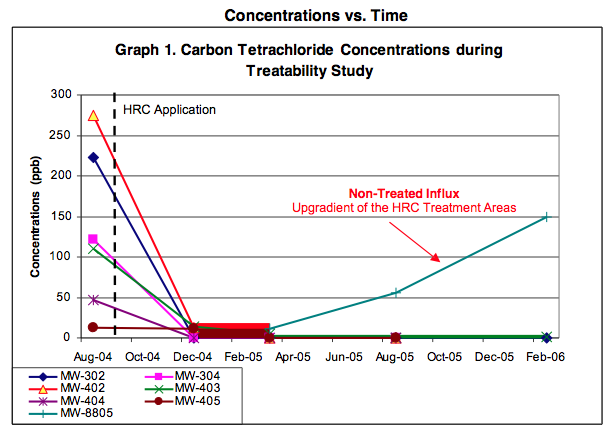
During the same sampling period, a continuous increase in the concentration of carbon tetrachloride was observed in well MW-8805 upgradient of the treatment areas. This increase is indicative of an influx of additional contamination to the area, which is assumed to have also occurred within the nearby treatment areas. Importantly, the contaminant levels within the HRC-affected wells remained below 5 μg/L during this period, indicating the effective treatment of both resident and influx carbon tetrachloride.
Benzene Concentrations Declined Up To 98%
Baseline benzene concentrations exceeded 150 μg/L prior to the treatability study. Reducing conditions were established shortly after the HRC/HRC Primer injection, and concentrations declined 56% – 98% over the following 18 months. Concentrations are expected to reach the cleanup goal of 5 μg/L as HRC continues to be effective in the subsurface.
Chloroform Concentrations Reduced to Cleanup Standards
Initial chloroform concentrations were above 20 μg/L. Six months post-HRC application, 3 out of the 6 HRC-treated wells sampled below the MCL of 0.15 μg/L. Within 12 months, the cleanup goal was reached in all wells except MW-403 (2.3 μg/L).
1 In the presence of certain microbes, Dechloromonas strain RCB and strain JJ, Benzene can be degraded anaerobically (Coates, J. D., Chakraborty, R., Lack, J. G., O’Connor, S. M., Cole, K. A., Bender, K. S., Achenback, L. A. “Anaerobic Benzene Oxidation Coupled to Nitrate Reduction in Pure Culture by Two Strains of Dechloromonas.” Nature June 28, 2001: 1039-1043.)
PCE and TCE Remediation at a Dry Cleaning Facility
SITE SUMMARY
Subsurface investigations at this operating dry cleaner site revealed elevated levels of PCE and TCE in the site soils and groundwater (perched aquifer). Soil remediation was accomplished via over-excavation in June of 1998. Accelerated bioremediation using HRC was selected to treat the groundwater contamination. The HRC application approach was chosen because it minimized disturbance to site operations. Most importantly, the site was granted closure status 17 months after initial HRC treatment.
REMEDIATION APPROACH
- Remediation Objective: Reduce concentrations of chlorinated aliphatic hydrocarbons to target concentrations at the entire site. See Table 1.
- Application Type: Grid (Direct-Push Injection)
- Product: HRC
- Quantity Applied: 10,020
- Application Rate: 10.37 lb/ft
- Injection Spacing: 5 ft on-center
- Product Cost: $62,340
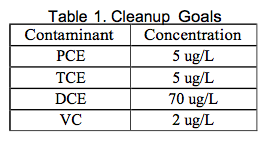
SITE CHARACTERISTICS
General
- Name: Arlington Strip Mall
- Location: Arlington, Texas
- Industry: Dry Cleaning
- Contaminants of Concern:
Hydrogeology
- Treatment Area: 3,000 ft2
- Soil Type: Clay
- Groundwater Velocity: 0.055 ft/day
- Groundwater Flow Direction: Southwest
- Depth to Groundwater: 7 ft
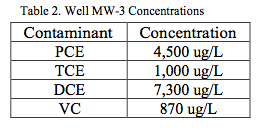

RESULTS
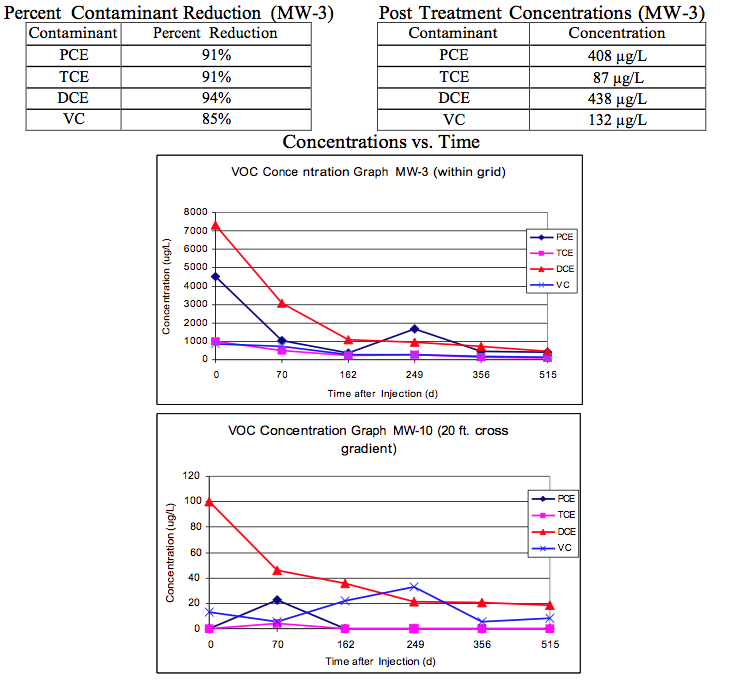
CONCLUSION
In an attempt to successfully treat the difficult to reach source area, directly beneath the facility, and to minimize building disturbance, 15 HRC injection points were installed on 30- degree angles (See site map). The site was granted closure approximately 17 months after the application due to the high degree of accelerated natural attenuation that resulted from the use of HRC at the site.
PCE and TCE Remediation at a Dry Cleaning Facility
SITE SUMMARY
A focused Site Investigation was completed for a dry cleaner site in Portland, OR. Results showed contamination levels of PCE as high as 120,000 ug/L in groundwater and 320,000 ug/L in soil. It is believed that the source of the contamination was a leaking sewer line beneath the facility. The high concentrations suggested the presence of Dense Non-Aqueous Phase Liquid (DNAPL) and a remedial technology was needed to address the distinctive contaminant concentrations. The HRC® application at this site is significant since it was the first time HRC-X® was injected, along with HRC, to treat VOCs. The extended life expectancy of HRC-X, 2 times-3 times that of HRC, made for a feasible option to reduce the high concentration of PCE. A pilot study was implemented using HRC to target the area near wells MW-1, MW-2, and MW-4 while HRC-X was injected near JEMW-4, the projected area of DNAPL.
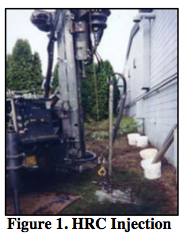
REMEDIATION APPROACH
- Remediation Objective: Pilot Study to prove HRC applicability at the site.
- Application Type: Grid (Direct-Push Injection) for both applications
- Product: HRC and HRC-X
- Quantity Applied: 1,920 lb of HRC and 1,680 lb of HRC-X
- Application Rate: HRC – 6 lb/ft; HRC-X – 9 lb/ft
- Injection Spacing: Variable distances, see site map
- Product Cost: $11,520 HRC; $11,760 HRC-X
SITE CHARACTERISTICS
General
- Name: Springdale Cleaners
- Location: Portland, OR
- Industry: Dry Cleaning
Hydrogeology
- Treatment Area: 9,100 ft2
- Soil Type: silty clay and silty sand
- Groundwater Velocity: 0.68 ft/day
- Groundwater Flow Direction: Southwest
- Depth to Groundwater: Variable
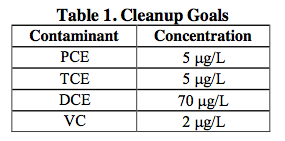

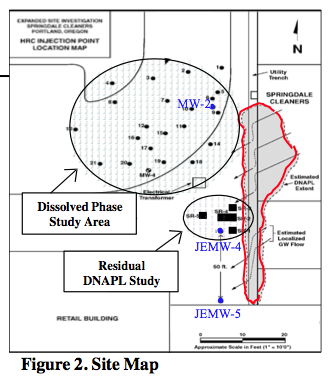
RESULTS
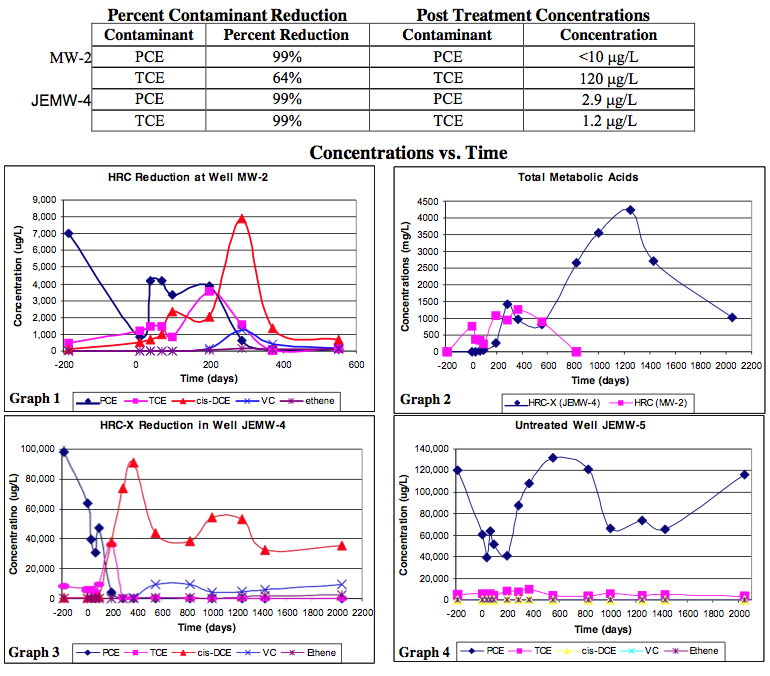
CONCLUSION
HRC performance in MW-2 produced sustained degradation of PCE and TCE as well as their breakdown products over roughly a two year period (Graph 1). HRC metabolic acids peaked around 1300 mg/L after a year then tapered off over time (Graph 2). HRC-X performance in JEMW-4 and JEMW-5 indicates unprecedented performance in terms of contaminant reduction and total metabolic acid production and longevity. JEMW-4 shows significant reductions in high concentrations of 100,000 ug/L PCE to near non-detect (ND) levels in approximately 300 days (Graph 3). PCE levels continue to remain at very low levels for greater than 5 years after HRC-X application. TCE was also reduced significantly from 90,000 ug/L to approximately 35,000 ug/L in close to 4 years. Daughter products such as cis-DCE and VC have been produced as a result of the parent product breakdown and are eventually expected to dissipate. Metabolic acids remain high (1000 mg/L) as a result of the HRC-X application. HRC-X continues to reduce high concentration PCE and daughter products TCE, cis-DCE, and VC more than 5 years after injection.

 Americas
Americas Europe
Europe Français
Français Deutsch
Deutsch Italiano
Italiano Español
Español

